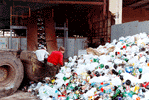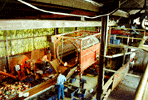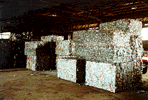

.....Here's how we separate the mix of tin cans, glass bottles and plastic jugs the we collect from you. Ever wonder what happens to old newspapers? Did you know that the magazine you read last year may be in the napkin you use today? The story and pictures below help explain.
.....Pickle jars turn into soda bottles, juice cans become storm doors and milk jugs change into lawn chairs. It's not magic, it's recycling, and for most Pennsylvanians, it's part of daily life.
....."Recycling reduces pollution, saves energy, preserves natural resources, conserves landfill space and provides additional jobs. It has wide popular appeal," comments Pat Mascaro, president of J. P. Mascaro & Sons, a Harleysville, PA, based solid waste collection, recycling and disposal company. "And today, it's an essential part of the trash business."
.....But how does it work? What happens to discarded bottles, cans and newspapers after they are picked up at curbside or taken to a recycling center?
.....A typical recycling story begins at home, where certain kinds of waste are kept separate from the rest of the trash. These might include cans; plus jars and bottles, both glass and plastic. Newspapers are tied or put in paper grocery bags. The exact type of recyclables to be separated depends on where you live.
.....The recyclables are set out on designated trash nights, or they may be taken to a local recycling center; again this depends on where you live.
.....Next, the recyclables go by private or municipal haulers to a recycling facility, such as Mascaro's Wyoming Valley Recycling in Nanticoke, PA, or its Bridgeport, PA, facility.


.....When the recyclable waste arrives, it is dumped from the trucks and loaded onto a conveyer that carries it to the top of a three story high sorting machine. Electromagnets first remove the tin (actually steel) cans and all other magnetic material. Then the recyclables pass over a vibrating screen where bits of broken glass and other scraps drop through. Next, a continuous blast of air then sorts the light weight plastics and aluminum cans from the heavier glass.
.....The light weight material goes into a mechanical sorter where the smaller cans are separated from the larger plastic bottles, or onto a conveyor belt where aluminum and plastics are manually sorted into separate bins. The glass goes to another conveyor where workers sort it by color.

..... Aluminum and steel cans go to mills where they are melted and used to make all kinds of new products, from cars to cans. Plastics manufacturers shred the recycled waste and use it to make everything from counter tops, to chairs to new containers.

..... Recycling is required by law in all municipalities with a population of 5,000 or more. Mascaro provides curbside recycling to all its residential customers.